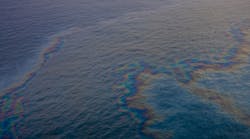Owner of Offshore Oil Rig Agrees to Pay $1 Million for Clean Water Act Violations
ATP Infrastructure Partners LP, the owner of an offshore oil rig that was stationed about 50 miles off the coast of Louisiana until earlier this year, has agreed to pay a $1 million civil fine to resolve a federal lawsuit alleging that the firm illegally discharged oil and chemicals into the Gulf of Mexico.
EPA, the Justice Department and the Bureau of Safety and Environmental Enforcement filed a lawsuit in February 2013 alleging that the ATP Innovator oil platform violated the Clean Water Act and the Outer Continental Shelf Lands Act. The lawsuit is the first that EPA and the Bureau of Safety and Environmental Enforcement have filed in response to alleged violations of the two environmental laws.
A 2012 Bureau of Safety and Environmental Enforcement inspection of the ATP Innovator alleged unlawful discharges of oil “and a piping configuration that routed an unpermitted chemical dispersant into the facility’s wastewater discharge pipe to mask excess oil being discharged into the ocean,” EPA said in a news release.
The original lawsuit was filed against ATP Infrastructure Partners and ATP Oil & Gas Corp., the latter of which operated the ATP Innovator platform. The case against ATP Oil & Gas is pending in the U.S. District Court for the Eastern District of Louisiana. ATP Oil & Gas filed for bankruptcy in 2012.
Earlier this year, ATP Infrastructure Partners removed the Innovator platform from operation and towed it to port in Corpus Christi, Texas. Before the platform returns to service, the company “must remove and seal the connection on the wastewater discharge outfall pipe that was used to inject chemical dispersants, thereby permanently eliminating the access point for improperly injecting dispersants into the wastewater discharge pipe,” EPA noted.
Also, prior to any future use of the ATP Innovator for exploration, development or production activities in U.S. waters, ATP Infrastructure Partners will have to certify that:
- The platform has sufficient wastewater treatment equipment and operational plans to meet and maintain Clean Water Act permit discharge limits and prevent unlawful discharge of pollutants to offshore waters at all times.
- The platform’s surface production safety systems will be maintained in a manner that provides for protection of the environment under Bureau of Safety and Environmental Enforcement regulations.
- All facility operations will be performed in a safe and workmanlike manner in accordance with Bureau of Safety and Environmental Enforcement regulations.
If the platform is used or leased in the future by ATP Infrastructure Partners or a related entity, the company will be required to have the ATP Innovator’s wastewater treatment operations and surface production safety systems independently audited for Clean Water Act and Outer Continental Shelf Lands Act compliance.
“Discharging oil illegally can foul water, harm wildlife and is unfair to companies that follow the law," said Cynthia Giles, assistant administrator for EPA’s Office of Enforcement and Compliance Assurance. "It is our obligation to protect local communities and companies playing by the rules.”
The proposed consent decree is subject to a 30-day public comment period and court review and approval.
